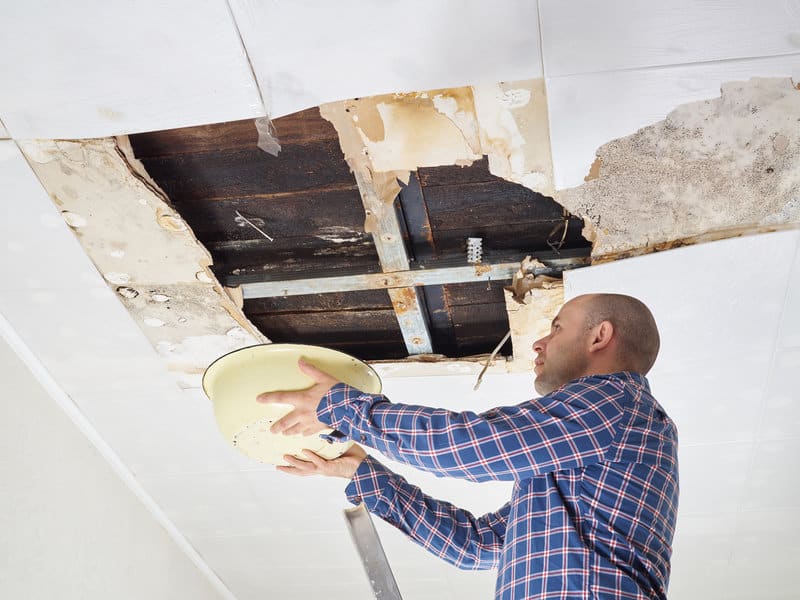
There are two dreaded words that every homeowner doesn’t want to hear: leaky roof.
The damage from a leaky roof can range from compromised structural integrity to health concerns from molds. And if roof repair is not given precedence, you might get used to running with a drip bucket every time it rains, which can be very frustrating.
Worse even, small leaks can become a big problem within a short time, leading to rotten wooden framing, and ruined insulation.
In an effort to save you the trouble of having to deal with a leaky roof, we’ve curated a list of the 10 major causes of roof leaks, so you can spot the highly likely leak spots and take the necessary action.
Read on.
Preventing a Leaky Roof
Age
Over time, roofing materials age and become less effective at protecting you from weather elements.
Prolonged exposure to changing temperature causes expansion and contraction of the roof, which in turn makes them brittle. Once brittle, they become susceptible to cracks, creating a pathway for penetration of water.
The average lifespan of asphalt shingles, for example, is 15 to 30 years. Beyond this age, they tend to weaken and become ineffective at protecting you from harsh weather.
Holes
A hole in a roof is an obvious gateway for water penetration. Holes can result from natural causes such storms, or human activities such as removal of a former antenna bracket.
Holes can also result from misplaced roofing nails. Regular inspection of the roof for such holes is a good preventive measure.
Missing Shingles
If you find a shingle lying in your backyard, you may not escape a leaking roof during the next rainstorm. Strong winds can rip shingles off your roof, leaving an exposed area where you might not see.
Again, regular inspection of your roof should help you discover such vulnerabilities.
Replacing a shingle is an easy task and shouldn’t take much time. It’s just a matter of prying off the nails from the course below and sliding the new shingle into place.
Flashing
Flashing refers to the thin pieces of impervious material (usually galvanized steel or aluminum) used over joints in roofs to prevent water seepage.
Flashing is usually placed around the edges of a skylight, where a chimney penetrates the roof, or where the roof joins a dormer. For a chimney, the material is bent at a 90-degree angle to attach the brick chimney to the roof properly.
If nails are loose or missing, flashing sections may slide out of place, creating a pathway for water to seep through. Water joints can also weaken over time due to the constant exposure to the elements.
Proper installation of flashing materials and regular check up of the likely leak spots can help reduce the incidences of flashing leakages.
Brick Chimneys
If you were to look at old ruins, especially those over 300 years old, you’d realize that the chimney is often left intact, even where the roof is ripped off. While the brick chimney may look indestructible, it is not impervious to water.
The mortar that binds the bricks together is made of nothing more than the ordinary sand, cement, and water. Prolonged exposure to elements can cause it to erode and crumble.
Regularly inspect the mud cups at the top of the chimney for cracks and deterioration. If you see any sign of erosion, plan for a quick fix.
Debris
Accumulation of debris such as leaves or twigs can trap water on top of the roof and allow it to seep in through capillary action.
Keeping your roof clean is important, as it permits water to exit the roof quickly.
Make a habit of trimming the tree branches that hang over your house. This prevents leaves and twigs from accumulating on the roof and in the gutter.
Slope
Roof slope, also known as pitch, is measured as the ratio of a roof’s vertical rise in inches over a 12-inch horizontal distance.
For installation of asphalt shingles, the International Building Code requires the roof slope to be at least 2:12. A double layer of underlay material must be used for all roof slopes between 2:12 and 4:12.
If your roof slope is too shallow, it makes it easier for the wind to rip off shingles and drive water underneath. Ensure that your roof tops are properly installed by a professional, and material used are appropriate for the pitch.
Attic Condensation
As the uppermost part of your house, the attic is trapped between outdoor and indoor temperatures. When the two clash – think of cold winters and hot summers, condensation will form, which results in moisture.
Excessive condensation can lead to water damage in your ceilings and drywall. A musty odor and mildew growth are a clear indication of the presence of moisture in your attic.
You can prevent attic condensation by installing a large ventilation fan, and ensuring the roof vents are clear from the interior.
The Skylight
Skylights help to create an airy feel in a house where natural light is too limited. They do a stellar job at bringing light into your home. However, they can also cause a leaky roof if not properly installed.
If you notice some wet spots or traces of water on the downhill side of a skylight, it’s a sign your unit is performing it’s unadvertised function: leaking!
Proper installation and regular checkup of the skylight for cracks can help prevent leakages of this kind.
Ice Dams
An ice dam refers to the accumulation of ice at the edges of a roof, which results from melting snow reaching the eave and freezing there, forming a ridge.
As snow melts and water runs down the roof, it is stopped by this ridge. The water then adds up to the ice dam, increasing the weight of the ice, which can also damage the roof.
Eventually, the ice backs up under the shingles where it melts and finds its way into your house.
Better ventilation in the attic and use of ice melt products to remove ice dams can help to prevent water leakage that results from ice dams.
Final Thoughts on Leaky Roofs
A leaky roof is inconvenient at the best times and highly damaging at the worst times.
Instead of letting a leak force you to take action, it’s important to take effective maintenance measures. Knowing the causes of roof leaks can help you take preventive measures, as well as identify the highly likely leak spots.
If you are ready to have your roof inspected and repaired by professionals, contact us today. We provide top-notch roofing and repair services and have been in the business for over 15 years.

